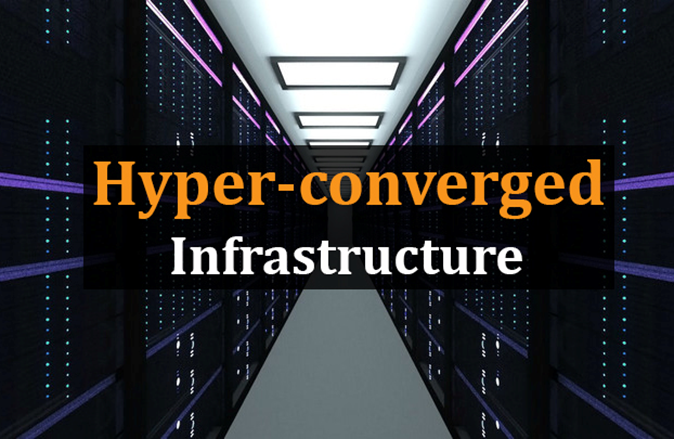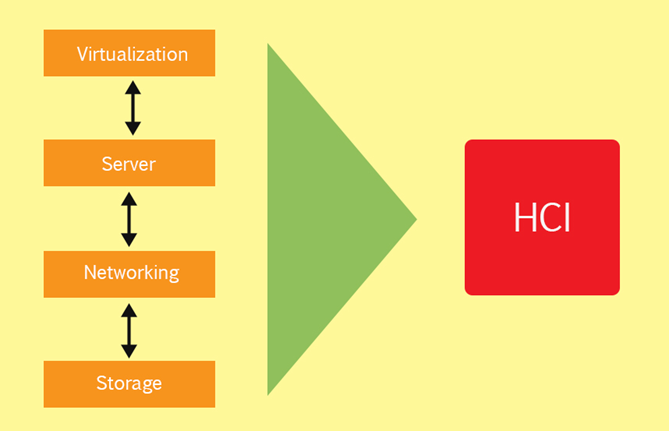
What is Hyper-converged Infrastructure?
Business organizations’ eagerness for new technologies never ends. They are always searching for new IT capabilities to streamline their business processes. The cost and the efficiency of systems are the important elements to be considered when investing in new IT infrastructures. Data centers can be considered as a key business parameter in workload management of business enterprises. Data centers provide computing and storage facilities and networking resources that require to run enterprise operations. Though the emergence of cloud computing had a significant impact on the data center architecture, some data and operations are still well-suited for on-premises data centers. Public clouds are not always suited to all types of enterprise data. But, again, on-premises data centers are too complex and costly to build and operate.
Hyper-converged Infrastructure (HCI) has been introduced as a new data center architecture to overcome previous architectures' downsides. Hyperconvergence is a software-centric data center architecture that merges all the components of legacy data centers, including compute, storage, networking, and virtualization, into a single unit. This architecture consists of scale-out capabilities and also minimizes the complexity of the data center operations. In contrast to the traditional hardware-based architecture, HCI has a software-defined approach that establishes the connection between computing, storage, and networking using software tools. HCI uses hypervisors for virtualization, and all the software that supports hyper-convergence run on the industry-standard x86 servers.

A Hyper-converged appliance is a hardware device that assembles all the components required to run a hyper-converged data center, including compute, storage, and networking components. HCI can be implemented either with appliances purchased from a single vendor or installing software tools on existing hardware components. While the hardware-based HCI implementation providing higher integration and optimization capabilities, the standalone software approach cuts down the cost of hardware. A simplified architecture, supporting cloud integration, and lower operational cost is one reason organizations adopt HCI. According to a report of Allied Market Research, in 2018, HCI market size was valued at $3.18 billion, and they predict that it will reach $33.16 billion by 2026.
How Hyper-converged Infrastructure works?
Hyperconvergence is more of a marketing term than technical jargon. Therefore, it’s difficult to find a standard definition or standard guidelines to implement a system. There is a number of vendors that provide HCI solutions to clients.
VMware, one of the leading HCI solution providers, is transformed the industry-standard x86 servers and direct-attached storage into HCI using an advanced server management software called vCenter server. VMware’s HCI solution consists of vSphere hypervisor, vCenter server, and vSAN, an enterprise-class storage solution. This virtualization software abstracts the underlying resources and dynamically allocate them to an application running in virtual machines. VMware’s storage policy framework, known as Storage Policy-Based Management (SPBM), eliminates the maintaining of LUNs, volumes, and data services. Policies are created with rules and define characteristics such as availability and performance. These policies can be assigned to virtual machines, and later, they can be changed when the requirements have changed. vSAN can perform deduplication and compression in order to save storage space.
Nutanix, another HCI solution provider, has two main parts in their HCI platform, namely the distributed plane and the management plane. The distributed plane runs across a cluster of nodes delivering storage, virtualization, and networking services for guest applications. The management plane allows easy management of the HCI components from one place.
The difference between Converged and Hyper-converged infrastructure.
Converged infrastructure (CI) is a data center management architecture that combines components similar to HCI, including compute, storage, and networking. CI also promised to provide efficient and cost-effective data center management solutions with any innovative data center architecture than legacy systems. Though both CI and HCI approaches intend to simplify the data center operations, they have some differences as well. Also, note that HCI is not intended to replace the CI. The main difference between the two architectures is that HCI has a software-defined approach, and CI is hardware-based, and components are pre-configured.
Though the hardware and software of CI come from a single vendor, components are not integrated. They can be separated, which means a server or a storage component removed from the CI system can be used for another purpose. These components act independently and able to scale up or scale down according to the changing business requirements.
HCI's software-defined approach enables full integration between components and cannot be separated because it is implemented as a virtualized environment. Compared to CI, HCI is more flexible and can be easily scalable. When new servers add to the system, additional compute storage and memory capacities will be added with them.
The Benefits of Hyper-converged Infrastructure
The software-defined approach and highly virtualized environment of HCI offer a number of distinctive benefits to businesses.
Centralized management
By shrinking components to a single physical appliance, HCI enables centralized and simplified management, which means all data center operations can be managed from a single control panel.
Scalability
When businesses grow, new data center resources need to be added to the system. Scaling-up of resources is necessary for future operations. Because of the software-defined approach, new nodes can be added to the cluster easily, and HCI software identifies and integrates them into the cluster.
Data protection
HCI consists of efficient data managing methods such as snapshotting, deduplication, self-encrypting drives, etc. Also, HCI enables a high level of data protection by providing disaster recovery and backup options.
Easy automation
Hardware-based data center architectures are too complex, and therefore, it’s difficult to achieve full automation. But the software-defined architecture of HCI makes possible the easy data center automation.
Cost reduction
Since the HCI merges compute, storage, and networking components into a single unit, the cost for power, hardware, maintenance, and support can be reduced.


